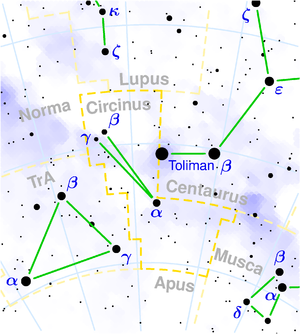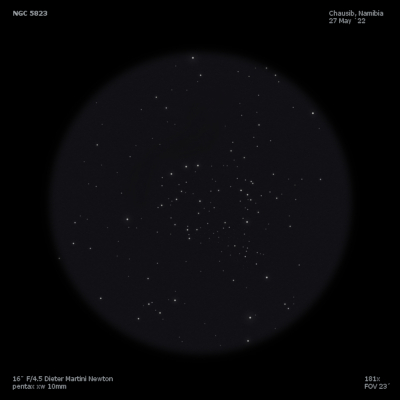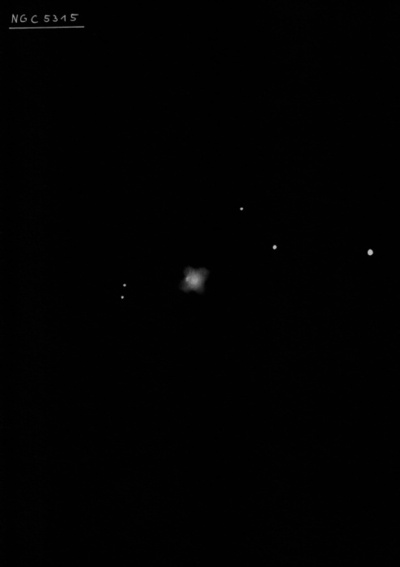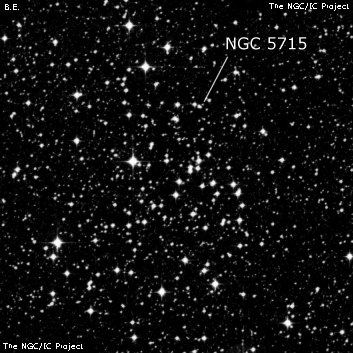 A small and faint constellation of the southern sky that we can never see in our latitudes. The narrow isosceles triangle formed by the constellation's three brightest stars lies wedged between the Musca, Centaurus, Norma and the Triangulum Australis in the Milky Way. There are no interesting objects in this small constellation near the conspicuous α and β Centauri, despite lying in the Milky Way, and its faint stars are not even named.
A small and faint constellation of the southern sky that we can never see in our latitudes. The narrow isosceles triangle formed by the constellation's three brightest stars lies wedged between the Musca, Centaurus, Norma and the Triangulum Australis in the Milky Way. There are no interesting objects in this small constellation near the conspicuous α and β Centauri, despite lying in the Milky Way, and its faint stars are not even named.
At positions 14 47.8 (RA) and -66 17 (Dec), you can discover the South Kemble Cascade, a purely random grouping of individual constellations in the constellation of the circle in binocular. However, in comparison to the original, it is slightly shorter and contains up to two streams of stars that merge in the north. More striking is the straight, forty-five minute long western array consisting of eight stars. The eastern row contains the same number of stars, but is a little twisted, and its brightest star is Dzeta Circinus. The other joining stars in the south give the whole cluster a necklace-like appearance.
α Cir - The brightest star of the constellation has an apparent magnitude of 3.4. At a separation of 15.7 arcseconds, there is a companion with a magnitude of 8.6, which can already be resolved with a telescope with a 6 cm objective diameter. The system is located at a distance of 54 light years.
β Cir - A main sequence star with a visual magnitude of 4.1, shining from a distance of 97 light years.
γ Cir - A binary star composed of components with magnitudes 5.1 and 5.5 in close proximity of only 0.6". It is a good test for a 150 mm telescope. The components orbit each other every 180 years.
NGC 5823

James Dunlop discovered NGC 5823 = D 351 = h3589 on 8 May 1826 and described a "pretty large cluster of small stars resembling faint nebula, general figure round, south preceding 2 Pyxidis." His position is 8' east of the center of the cluster. JH made a single observation in Apr 1836 and noted "Cluster class VII; a fine large cluster of separate stars 13..14th mag, 10' diameter; not much compressed in the middle; nearly fills the field." Neither JH nor Dreyer credited Dunlop with the discovery.
400/500mm - 18" (7/5/05 - Magellan Observatory, Australia): this is a rich, fairly impressive cluster using the 27 Panoptic (76x) with at least 80 stars resolved in a 9'x7' area including numerous 11-13th magnitude stars. A number of stars are bunched towards the center. The periphery is well defined by curving sprays of stars roughly forming a heart-shape. Two 10th magnitude stars mark the NW and SW corners of the cluster. Perhaps 100-120 stars are resolved at 228x with a number of stars in pairs, trios, small groups, strings and arcs forming a very pretty cluster.
Notes by Steve Gottlieb
NGC 5315

Ralph Copeland discovered NGC 5315 on 4 May 1883 near Lake Titicaca in the Andes. He was using a 6.1" refractor fitted with a direct vision Vogel-spectroscope (NGC 5873 and 6153 were discovered the same way). The RA given in Copernicus III (1884) is 30 sec too large.
400/500mm - 18" (7/5/05 - Magellan Observatory, Australia): picked up by blinking at 128x with an OIII filter, though immediately noticed as non-stellar at this power. At 228x, appeared as a bright, compact, very high surface brightness 5" disc with a bluish color distinctive of high surface brightness planetaries. There was only a modest contrast gain with a UHC filter. Excellent view at 293x, though there was no sign of a central star within the high surface brightness haze. Located 4' E of mag 7.1 HD 120680. A couple of fainter stars are close following.
Notes by Steve Gottlieb
NGC 5715

James Dunlop discovered D 333 = h3577 on 8 May 1826 and described "a group of small stars with faint nebula. There is rather a gathering of the nebulous matter, about 10 arcseconds diameter, near the north side." His position was 10' west of center. JH observed this cluster on 9 Jul 1834 and logged, "cluster VII. Pretty rich, stars 11..13th mag, irregular, scattered,10' diameter, rather more comp M." JH credited Dunlop with the discovery.
300/350mm - 14" (4/3/16 - Coonabarabran, 178x): this cluster appears to extend 7' to 8' in diameter but the eye-catching portion is a small, distinctive group of similar mag stars on the west side, forming an striking oval ring or loop. Within this 2.5' curving chain are roughly two dozen, mostly mag 12.5-13.5 stars and the interior of the loop is nearly devoid of stars. A mag 10.7 star is a couple of arcminutes east. Roughly 50 additional stars are in the surrounding portion of cluster, for a total of ~75 stars. A mag 9.3 star (HD 129144) is 5' S.
Notes by Steve Gottlieb